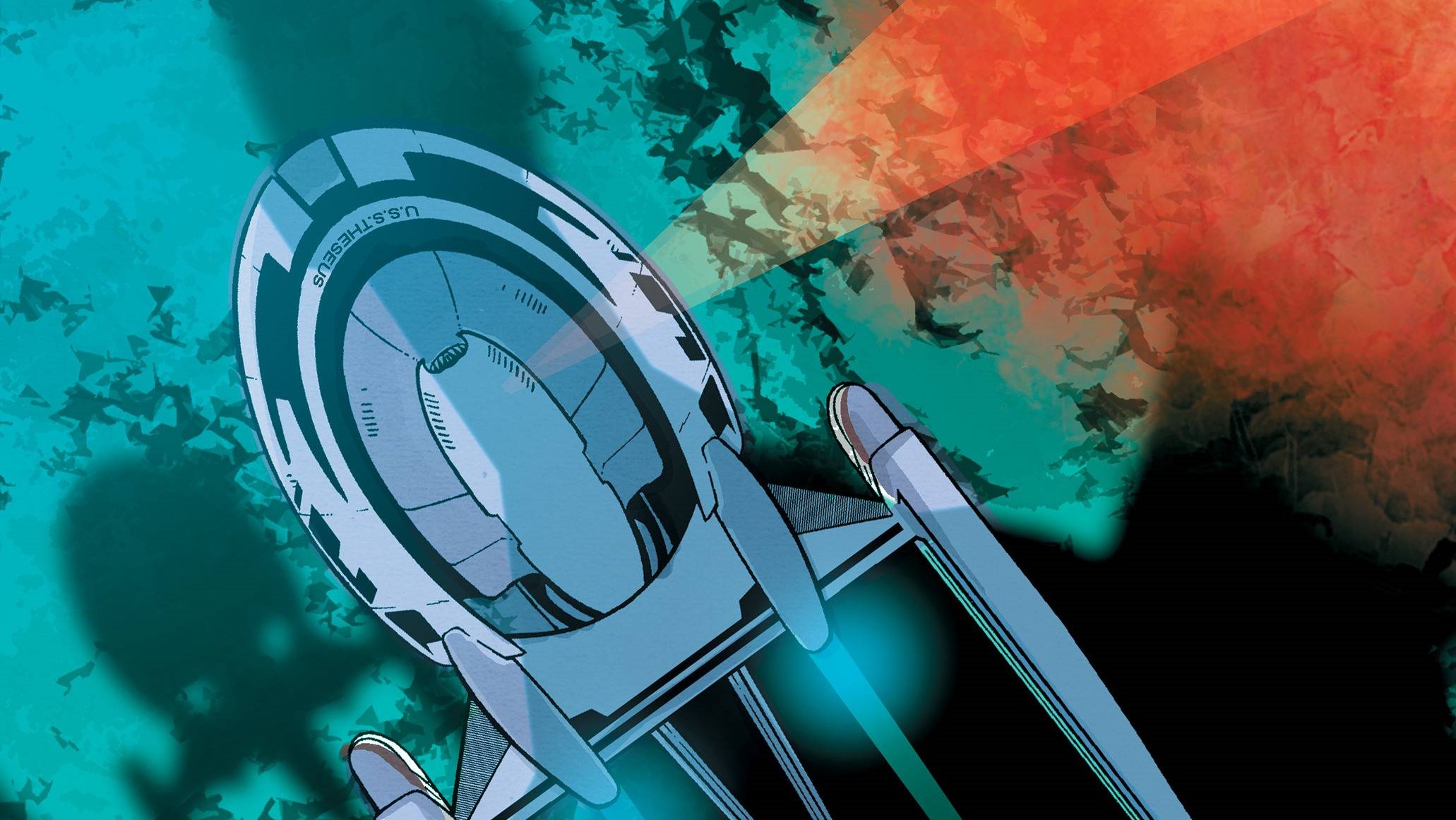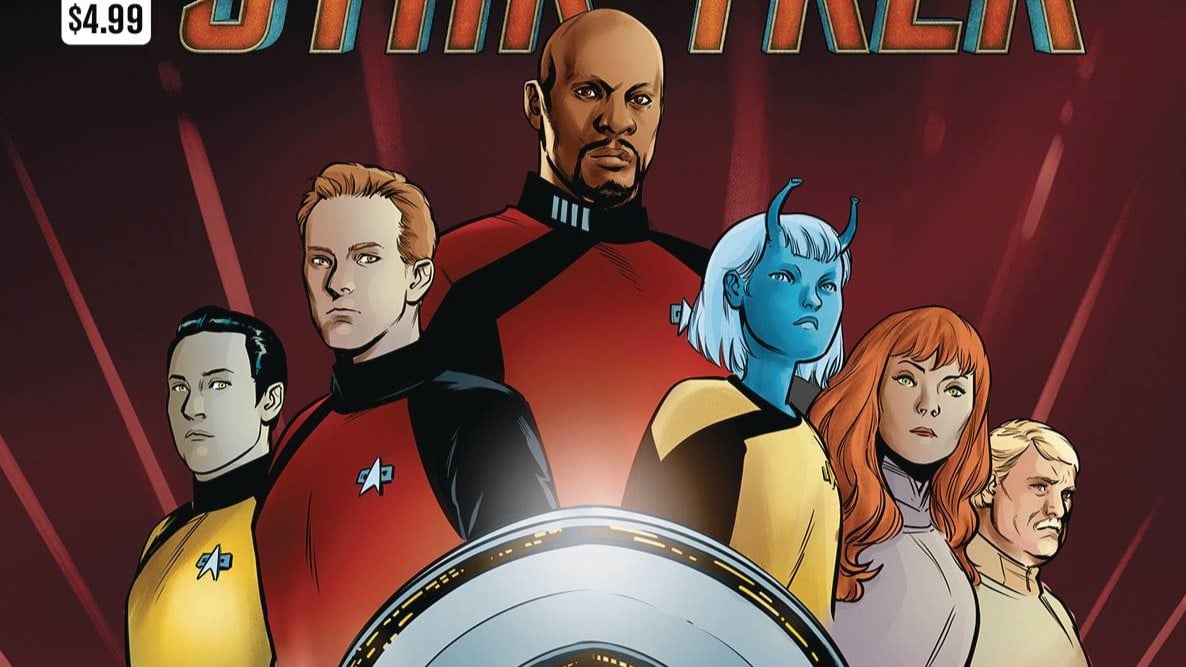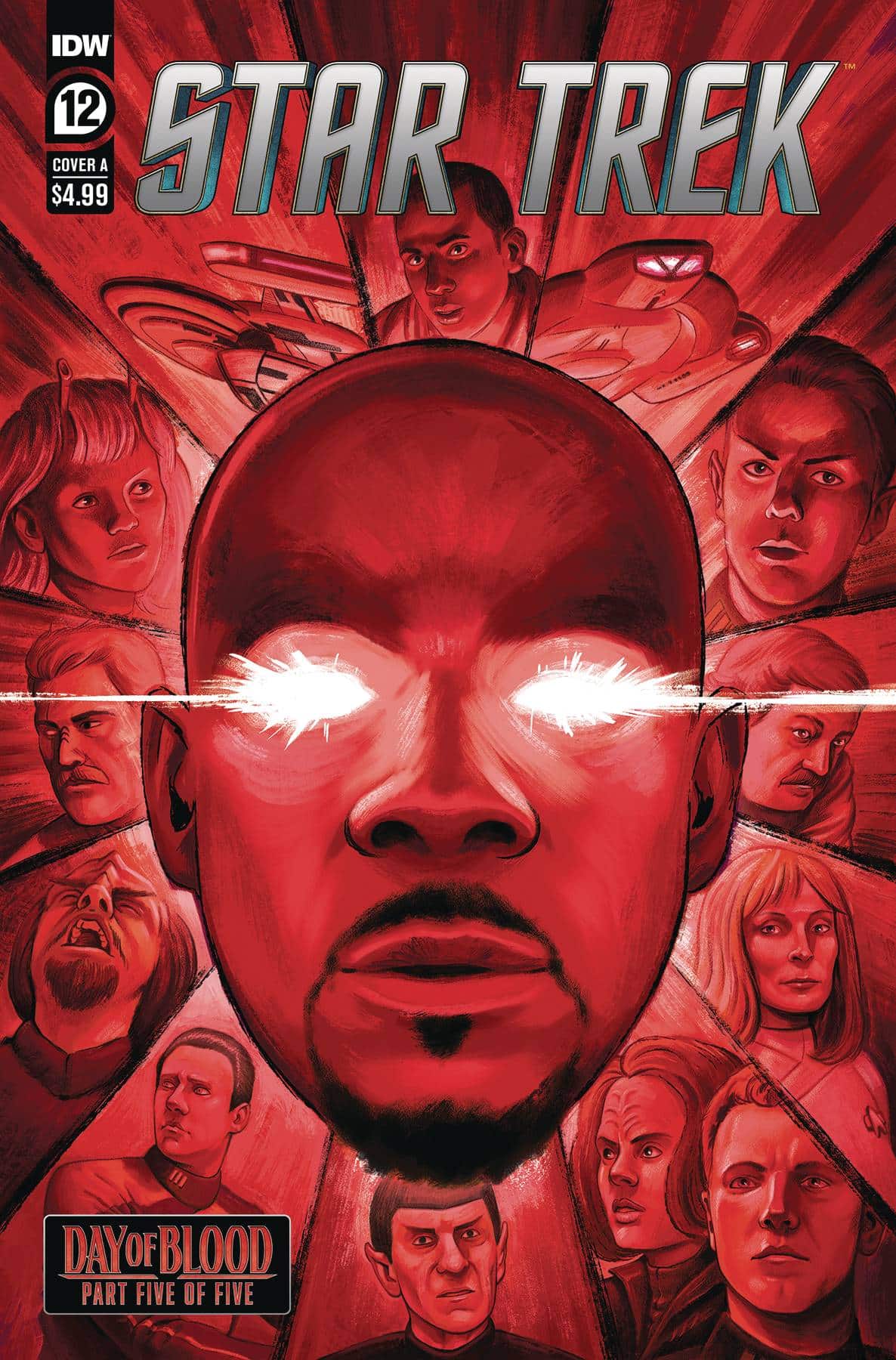Having been tipped off by Q, Ben Sisko and the Theseus crew race to the God City of T’Kon and find much more than they bargained for in Star Trek #4 written by Collin Kelly and Jackson Lanzing, with art by Ramon Rosanas and Oleg Chudakov, colors by Lee Loughridge and letters by Clayton Cowles.
Mark Turetsky: Hey Tony, you ever feel like we’re just ants? Like, in the grand scale of the universe, we’re just tiny particles, living on a speck of dust flying through eternity?
Tony Thornley: You know, contemplating the vastness of space always makes me feel small. But this Star Trek #4 sure amplified that with some BIG reveals, literal and figurative.
Tracking a God

Mark: Star Trek #4 starts with a clever combination of exposition and a quiet scene, the sort of scene I love seeing in a Trek comic. The exposition is for those of us who haven’t watched “The Last Outpost” in a long time (and why would you? That first season of TNG is pretty rough, doubly so when you include the “Yankee Trader” iteration of the Ferengi). The good stuff really starts with Sisko’s abortive conversation with Jake. Ramon Rosanas’ page layouts are exquisite: the overabundance of panels on the page reflecting Sisko’s fractured consciousness, with eyelines drawing the viewer’s gaze to two stacked panels near the center: Jake giving the reader (and Sisko) a direct gaze, with Sisko trying to connect, but literally getting cut off by the panel border. It’s fantastic stuff.
Tony: Absolutely. I didn’t expect the series to include an exploration of the father/son relationship of the Siskos. I’m glad it did, though. No family in the Star Trek franchise has really gotten as deep and thorough an exploration as the Siskos. Ben and Jake have always been disconnected, but loving. This shows how the three years since the end of the Dominion War hasn’t changed much, but also has changed everything. That pained look on Jake’s face was soul-crushing.
Mark: And the way these pages are full of words, with Sisko’s racing mind providing the narration, but very little actual dialogue, literalizing the idea of so many words being left unsaid between father and son. It also provides some insight into Sisko’s mind: he knows at some point the future, he’ll ask Jake a question, and that Jake’s answer will break Sisko’s heart. He’s still got some of the insight that comes with living among the Prophets, and the frustration and sorrow that comes with knowing that his future is predetermined.
Tony: I have a feeling that this is a set up to subvert the trope a little bit. It’s absolutely intended to point towards predestination, but it’s not actually intended to go there. Chekov’s paradox, if you will. It’s playing with not just Sisko’s fading divinity, but also the relationship they have.
Can we back up a bit to how cool the opening page is? Data pages have worked best as in-universe documents, which is exactly what Lanzing and Kelly have done so far in the series. I loved that they immediately transitioned that here into it being something Sisko is actively reading. There’s so much on that page about T’Kon, though.
This is a race so technologically advanced that I don’t think we’ve seen anything on their level outside of maybe the Borg. They rebuilt solar systems, for hell’s sake, and they did it on a massive scale. Their suspected territory is a huge chunk of the Alpha and Beta Quadrants. That’s so cool!
Mark: It’s a pretty massive amount of power that they wielded. It’s also somewhat mindboggling in the time scale as well, and reminds you just how big the universe is in that respect: they existed over 600,000 years ago. That’s a helluva long time for us to think about, in terms of people and civilizations, but the age of the Earth is measured in billions of years. The age of the universe is nearly 14 billion years. 600,000 years? That’s nothing. They lasted for 1,000 years as a spacefaring civilization? Less than nothing.
Tony: Exactly. Yet they had a massive impact that no one in the Federation or any other known entity might ever fully understand.
I mean, that was three pages of story, and we got a huge exposition dump, and a massive amount of character building. Then Star Trek #4 goes into another several pages showing that Sisko has a ship full of geniuses — T’Lir, Sato and Scotty are able to figure out a way to find the gods over a game of… Yahtzee maybe? It’s a bunch of technobabble, but it’s perfectly written Trek-nobabble.
Mark: What’s funny to me is that it’s mostly handled by T’Lir and Sato, with Scotty cutting through it and getting to the point. It’s interesting because when I think of Trek-nobabble, I think of Geordi, or O’Brien, or Data or any of the other engineers or scientists from TNG-onward. Or maybe even Spock, but mostly it was Scotty shouting about the engines being about to explode. It’s demonstrated perfectly in “Relics,” where Geordi explains to him about doing something to the power frequencies and the yadda-yadda, and Scotty replies, “You soured the milk.”
So he understands all of the tech stuff, but he doesn’t necessarily always speak in those terms. The young crewmembers are talking about the photovoltaic power array, or Kardashev tachyons, Scotty is talking about black holes, subspace and, well, gods.
Tony: It’s the thing that makes Scotty great right there, and Lanzing and Kelly get that. He’s as intelligent, if not more so than both of these kids, but he’s so much more practical. And again, Rosanas illustrated the hell out of this conversation. It’s so packed with detail, it has cool layouts, and the character acting is fantastic. Too many artists working on licensed properties struggle with the realism when mixing new and familiar characters. He does it just right, and Loughridge’s colors make the setting feel real. Really, the only fault I MIGHT see in this scene is I feel like it could have been enhanced by including Data.
Mark: Data’s graduated from hanging out with the science-heads in engineering to being first officer, I guess. He used to be cool.
The God City of T’Kon

Tony: And that brings us to stellar cartography, a section of every Starfleet ship that almost no one uses. Seriously, the number of times we’ve been in the stellar cartography lab of a ship…it has to be single digits. But it’s a great setting for Scotty, Sato and T’Lir to show Sisko how to track a god.
Mark: It certainly was a highlight of Generations, but yeah, pretty much nothing else comes to mind that’s set in stellar cartography. There’s one false note in this scene, or maybe it’s just a weird art decision. When Data questions the safety of flying off to explore the ancient God-city, Sisko responds with a “HA!” I’m pretty sure it’s meant to ape this moment from “Our Man Bashir:”
But having it shown in profile, it more looks like he’s yawning, or preparing to sneeze.
Tony: We’ve generally been praising the art in Star Trek #4, but that panel, and the panel of Sisko gripping the arm of his chair on the next page, were both extremely strange choices. I think Sisko’s dismissal of Data’s concerns was a little abrupt too. I wonder if that’s what it was intended to show. Sisko is grappling with his omniscience, but he’s not relying enough on his staff while doing so. It’s a flaw that I hope he overcomes.
So the ship very quickly rockets away to T’Kon, and I adored this reveal. One of my favorite sci-fi concepts is massive artificial structures. At first glance, that’s exactly what T’Kon is. But as they head into the city on impulse engines, they discover quickly that it’s so much more.
Mark: It’s got several planets (moons?) that it’s dwarfing. A structure that big should, in any rational universe, collapse in on itself and become a planet itself, or even a star, if it’s big enough. And I think the creators of this comic are aware of that and are saying, “no, the T’Kon were powerful enough that they could ignore the fundamental laws of the universe.”
The crew makes the choice to fly into this unthinkably huge structure, and they come to the realization that it’s a living organism, that it’s survived for half a million years alone in the vastness of space, living off of radiation it’s siphoned from the nearby black hole. Amazing stuff.
Tony: This is the most Star Trek concept possible, and I can’t think of any examples of it being done before! Can you?
Mark: There’s the Dyson sphere in “Relics,” but obviously that’s not original to Trek. What it reminds me of more is the “ring builder” species in The Expanse. They existed a long time ago, they’re gone now, but some of their machines are still around, and they’re terrifying and amazing.
Tony: Trek has hinted at a few species like that before, like the race that seeded intelligent life all across the galaxy. I think this the first that has been directly quite on this level.
Though the crew at first think T’Kon might be dead, they quickly begin to realize it’s not just still living but probably a god-like being itself. And what prompts that revelation? T’Kon wakes up and starts to bend space to defend itself. Yup, the Theseus is about to come face to face with the Godkillers.
Mark: I think we need to clarify our terms here. There were the T’Kon, the species that ruled the galaxy hundreds of thousands of years ago, and Data alludes to meeting one of them, referring to him as “just a man,” after which Dr. Crusher adds that the T’Kon was “just another empire of flesh and bone.” Then there’s The God City of T’Kon, the massive life form that maybe those mere mortals created. The mere people are long dead and gone. The God City is, as you say, very much alive.
Tony: Exactly. I’m just calling the God City of T’Kon “T’Kon” for simplicity.
Mark: Did you get vibes of the infinite improbability drive from The Hitch-Hiker’s Guide To the Galaxy here? The awakening of the God City and the later arrival of the Godkiller make spacetime very iffy for the Theseus. Interesting to note that, while Scotty, Worf and Sato report on readings from the ship, T’Lir seems to sense the emborkening of spacetime in their own body. Yet another clue, as if we needed one, that not all is as it appears with them.
Tony: Yes, exactly. This is the page where Oleg Chudakov takes over the line art, and he nails the tension here. Everything is falling apart quickly, everyone’s panicking. He gets that across in both the payouts and how the characters are moving on panel. It’s chaotic and unsettling. T’Kon is going into defense mode, and then a ship drops out of warp directly outside of the God City. The same ship they scanned in issue #1.
It’s a massive Klingon Bird of Prey.
They Filled the Heavens With A Terrible Sound

Mark: We get our big reveal of who, precisely, is behind the Godkiller Array, as Worf calls it. It’s Kahless. Now, it’s an interesting thing that Kelly and Lanzing are doing here in terms of Trek canon: we have Worf’s oft-quoted statement in “Homefront” that “Our gods are dead. Ancient Klingon Warriors slew them a millennia [sic] ago.” We also know that the time of Kahless was “a thousand years ago” (“Looking for par’Mach in All the Wrong Places”), but these two events were never really tied together.
Add to that the elaboration of the story of Molor: Molor has been mentioned in just about every Trek series from TNG and Discovery, but has never quite gotten the spotlight that Kahless has. But in all those mentions, he was usually just the anti-Kahless: the evil ruler that Kahless overthrew. Nowhere else but in this comic is Molor aligned with an interstellar power who propped him up.
On the one hand, this is a very good addition to Klingon lore. But it also diminishes the Klingon gods to flesh-and-blood ancient aliens. It seems to lessen their place in Klingon mythology from the gods who forged the Klingon heart with fire and steel to false idols that Kahless helped to drive away. I was also reminded of the Hur’q, an alien race from the Gamma Quadrant that sacked Qo’noS and plundered it of cultural treasures, but they’re likely not the aliens that bolstered Molor, since one of the relics they stole was The Sword of Kahless, the first ever bat’leth, implying they arrived after the time of Kahless.
Tony: And going back to Kahless himself — I should have seen this coming. I was looking for clues elsewhere, but Lanzing and Kelly laid it all out in issue #2. This is a wannabe fascist dictator looking to seize power. It started in the Klingon Empire. I mean, the only clue that didn’t line up was the silhouette in issue #1. I smacked myself in the forehead when it all came down. The only other possibility that could have worked in retrospect was Gul Dukat and the Pah Wraiths, and there was NO foreshadowing of that.
And as far as the lore goes, it’s another example of how this series is satisfying to hardcore fans, more casual fans, and even newer fans.
Mark: There’s another cool thing that Kelly and Lanzing are playing with here: In Worf’s personal log from nine years prior (after the events of TNG’s “Rightful Heir”), he laments that he no longer knows what to make of Kahless. He’s torn between his feelings about the words of Kahless and about the man, Kahless.
But here’s the thing: Kahless, this particular Kahless, is a clone. He’s not the same Kahless who was around a thousand years ago. He has the same genes, and therefore the same genetic predispositions, but his memories aren’t the memories of the living Kahless. They are the story told about Kahless a thousand years after his death, redacted who knows how many times over the centuries, told through the lens of Boreth monks. So in this way, Kahless is a kind of embodied story, a feral narrative set loose upon the galaxy, trying to retell itself. As a fan of Kieron Gillen, you know I love this stuff.
Tony: It’s Kahless the clone, living up to Kahless the Legend, when I’m sure Kahless the Klingon was not that horrific. I like how you’ve simplified it there.
So we’re left with Kahless taunting the crew, and the beginning of a race to the heart of the God City. Hell of a cliffhanger to end Star Trek #4 on!
Mark: Kahless says that the Federation has made a lap dog of Worf. Don’t forget, since Worf joined Starfleet, he’s killed Duras, killed Gowron and turned down the chancellorship before bestowing it on Martok. My money is on Worf to kill Kahless. He was instrumental in getting Kahless accepted, he can damn well smack him back down.
Prepare Yourself for Warp 10 Excitement!
- Sisko telling Worf to have a little faith is fun a) because this is a story dealing with space gods, but also b) if you’re plugged into the Trek-meming scene, faith is always, always followed by, “of the heart.” [Ed. Note: …I’m going where my heart will take me.]
- I hope the God City survives next issue, because man, I’d love a full arc exploring it.
- Speaking of Gul Dukat: Even with his defeat at the end of Deep Space Nine… he has to at least be on the road map, right? I mean, something has to be planned, even if it’s just a flashback.
- “Time to show off that reputation I’ve heard so much about.” “Literally my favorite thing to do, Captain.” I’m happy to have Tom Paris in this comic, if only for the memes.
- “Only those without honor stand against Kahless the Unforgettable.” Kahless is now defining Klingon honor as following him. Reminiscent of so many strongman dictators, past and present.
- The little whispered conversation between Data and Worf about the term “Godkiller array” is great.







